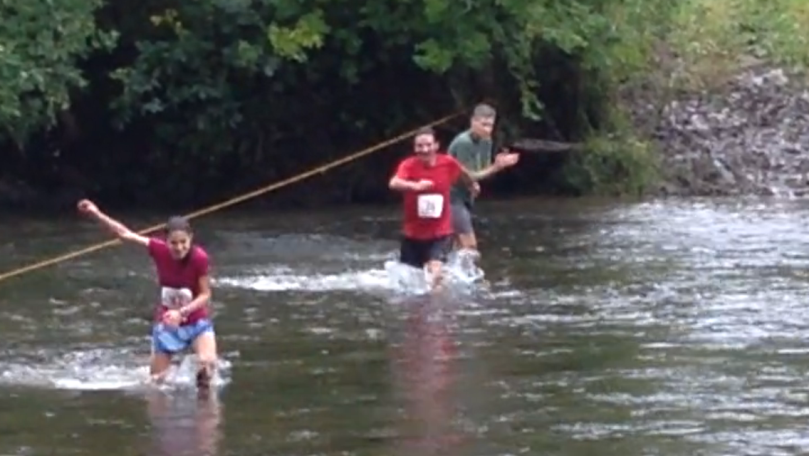For about 3 hours every year in the fall, a 250-acre secluded private property of woods, creeks and rolling hills outside of Philadelphia is open to runners who don’t mind getting their feet wet.
The playground for the annual Brandywine Bend Footrace, a 7.8-mile (12.6 km) trail race, is a landscape that has barely changed since George Washington was defeated by the British army in the 1777 Battle of Brandywine. The area’s beauty inspired the famous U.S. painter Andrew Wyeth, who lived nearby.
Drive five miles to the east, and you’ll find yourself in a typical American suburb: a two-lane highway with its lot of traffic jams, soulless shopping centers, fast-food chains, and residential development eyesores. But here on the private land of the late George “Frolic” Weymouth, a philanthropist, heir of the wealthy Du Pont family and close friend of Wyeth’s, nature is preserved.
“Frolic’’ — nicknamed after a family dog in early childhood — died in April this year. But when I first ran the race in 2014, I got the chance to see him, cruising around the back of his barn in a golf cart, mingling with runners post-race. The scene was charming: an old-fashioned gentleman in hat, scarf and round glasses, talking to sweaty, short-clad, pony-tailed individuals who happened to have crossed his creek by foot a little while before.
Instructions to get to the start was provided by the organizers via e-mail three days before the race. Once you enter the property, marked by two stone pillars, you follow “The Bend’’ signs — in 18th-century handwritten font, of course, as if Washington himself had written and planted them here. You drive another mile on dirt road, passing by grazing sheep, horses and the occasional house. After a last turn on the right, you get up to a grassy plateau overlooking the woods.
“It’s like a Wyeth painting come to life!’’ said my husband, himself a local, who was my chauffeur-cum-support-crew at this year’s race – along with loyal canine sidekick Gatsby.

The race is time-handicapped, based on age and gender — modeled after the famous cross-country Dipsea race in California. The start is staggered, with older and female runners given a head start — double head start when you happen to be both, like me. Whoever crosses the finish line wins.
The handicap gave me the unique opportunity to be in the same category as “girls under 18’’ and “men 50-53,’’ in wave F, starting 10 mins after the first runners.
After the usual stretches and last-minute trip to the Port-a-Potty, our eclectic wave of half a dozen runners gathered at the starting line. At our back was the property’s manor house, built in the 1780s, which is called the “Big Bend” after the sharp curve the nearby river takes down to the state of Delaware and back to Pennsylvania.
This year, I had planned not to “race,” just run the course and enjoy myself. I’d run a hilly 18-miler (30 km) the day before as part of a marathon training, fairly hard at about 7:20 per-mile pace (about 4:35 per km). So today would be a recovery run. But once we were off, I couldn’t help pushing myself. See, one of my fellow wave-F male runners took off right away. A second one was breathing down my neck. I knew that he would soon pass me too. He did — within a mile. These “men 50-53’’ had about a decade on me and I couldn’t keep up. Not good. (Consolation lot: I was still ahead of the “girl under 18.’’)
The first mile is a gentle, flat, leafy trail along the river. My legs were tired, and I had run out of time to properly warm up. As the two “men 50-53’’ gained ground ahead, I braced for the first steep hill of the course.

George Washington, when choosing a site to defend Philadelphia, then capital of the nascent nation, opted for the high grounds of this area. As I ran up and down through the trails and fields, I’d like to think I had profound reflections about the soldiers who battled here more than 200 years ago (a 20-year-old Marquis de Lafayette was wounded nearby). But the sore muscles, roots and slippery muddy slopes brought me back to the mundane present of a cross-country race. After a few near-misses, I made sure to slow down on steep downhills, taking no chance. I ungracefully crossed a little stream, — too shy to jump, I ended up with both feet in. I passed older runners while younger runners passed me, the way things should be.
Half way through the course is the chapel and then the maze (“There’s maze?” my husband asked). But the highlight of the race, especially after a rainy day, has to be the river crossing about a quarter-mile away from the finish. I approached in a clumsy way, my shoes already soaked from the aforementioned stream crossing. After another near-miss on the way down the muddy slope, rescued last-minute by a tree trunk, I tried to fight the current the best I could — which, based on photos and videos involved flailing my arms.

My tired legs invigorated by the cold water, I made a poor attempt at a sprint, failing to keep up with one of my fellow “men 50-53,’’ who passed me easily and arrived five seconds before I did. I’ve never been a good finisher (as many of my marathons can attest). I was the 12th runner to cross the finish line, the face smeared with mud and some 4 minutes slower than in 2014.
Soon, it was time to say goodbye to the “Big Bend,” get into the car and drive back to the 21st century.





Good story telling 🙂
LikeLike